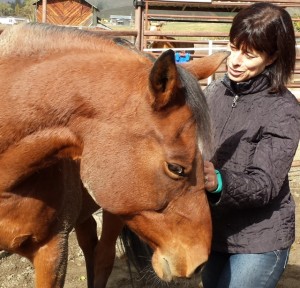Riding Beyond: An Amazing Experience By Robin Miller, MD MHS
Recently I was invited to attend a private horse experience that was designed to help women who are breast cancer survivors. I went, because I wanted to know how it could help my patients. What I found was something that would help all my patients and my colleagues as well. Horses are intuitive beings that sense our emotions, our hearts and they are healers.
My experience started with an excellent orientation by Trish, the horse trainer and her assistants Jennie and Hannah. Then, I walked into the ring by myself with Mystic, the therapy horse. She is small (for a horse), powerful and beautiful. She approached me and I allowed her to nuzzle my hand. Then for a brief moment she wrapped her powerful head around to the small of my back signaling that she wanted her back rubbed, which I did. Then I was instructed on how to rock her hips ever so slightly and she became very calm. After that I hugged her. I placed my hand on her back and pressed my body up against her side with my hand over her heart.
I felt like I could have stayed there forever. I was overwhelmed by something that is hard to describe. My heart opened and I felt a sense of pure love and acceptance and then I started to cry. It was amazing. What is really wonderful is that I remember the feeling. I am able to recall it when I feel scared or sad or insecure, and it comforts me.
Horses have been used as therapy animals for centuries. In more recent times, they have been used to help those with PTSD, children with autism and those with disabilities to name a few. They are highly intuitive, and their rhythmic movement is similar to the human walking pattern, which is soothing. Their reactions to touch, brushing, grooming and bathing can be very calming.
The Riding Beyond program has helped breast cancer survivors to feel accepted, strong and loved. For those that feel scarred and/or wounded, they feel whole. Mystic is quite a therapist along with her wonderful, caring trainers.
Therapy horses are amazing beings. They can help all of us ride beyond whatever obstacles we encounter in our lives. In my opinion, it would be a more peaceful world if we could all have a horse therapy session!
“Horse sense is the thing a horse has which keeps it from betting on people. ”
― W.C. Fields
comments off Robin Miller | Uncategorized |










